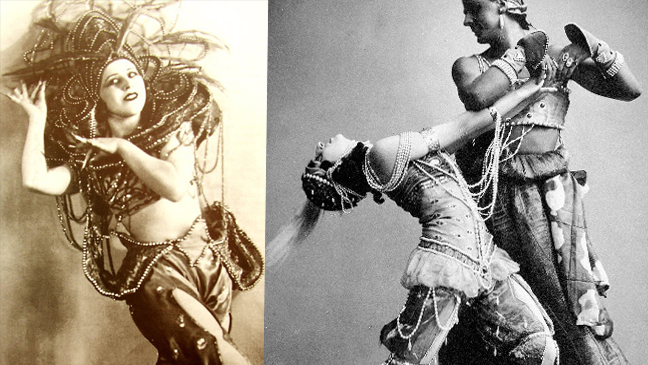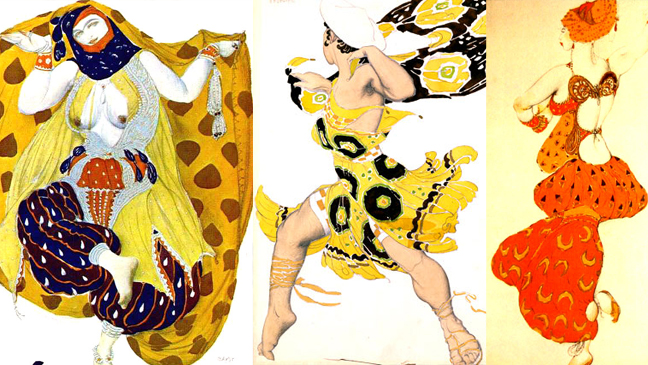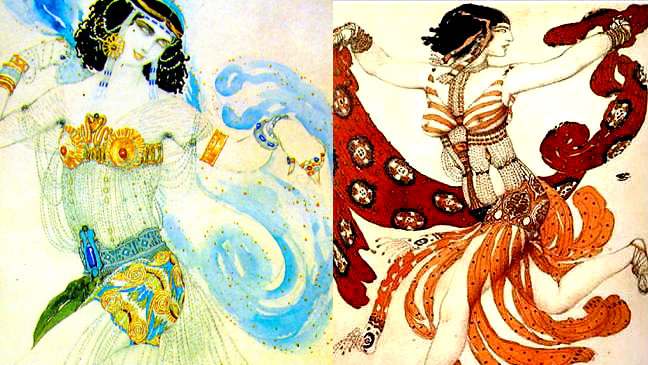
by Neon
Among the many influences that shaped the early “Oriental
fantasy” and early “belly dance”
look are the exotic costume designs done for the “Ballets
Russes” by Art Nouveau designer and illustrator
Leon Bakst.
His lavish, flamboyant, colorful costumes for “Scheherezade”
(Paris, 1910), "Cléopâtre"
(1910), “L'Apres-midi d'un Faune” (1912)
"Le Dieu Bleu," "Thamar," "Polovets
Dances" established the image of the Ballets
Russes, caused a sensation in the world of European
fashion and interior decoration, and had a direct
impact on the “odalisque,” “Salome”
and other early 20th-century dance costume themes.
Unlike classsical ballet costumes, Bakst’s costumes
freed the torso. The costumes were supported only
by the bra and hip belts.
Bakst’s Orientalist designs inspired Paul Poiret
who admired his work. Trend-setting fashion designer
of that era, Poiret introduced the “Directoire”
tube-like dresses and encouraged women to switch from
the corset to the bra. In 1913, as a tribute to the
Ballets Russes, Poiret produced bold-color heavily-beaded
and appliqueed fashion designs featuring harem pants,
“lampshade” tunic, "minaret"
skirts, turbans, exotic jewelled slippers and "barbaric"
(what we today call “tribal”) jewelry.
Even the "shocking" introduction of the
V-neck for day wear echoed the Orientalist trend.
Aigrettes replaced tiaras. Bakst designed Orientalist
fabrics for Poiret, dressing the European elite in
canary yellow, bright blue, jade, cyclamen, and henna.
Leon Bakst (1866-1924) was born to a Jewish family
in Grodno, Belarus, and studied at the Academy of
Fine Arts in St.Petersburg, Russia. He started his
artistic career as an illustrator for magazines and
soon expanded to stage and costume design. In 1909
he began his collaboration with Diaghilev, Russian
theater entrepreneur and founder of the Ballets Russes,
where Bakst became the artistic director. In 1912,
Bakst had to leave St. Petersburg (being Jewish, in
an era of state Christianity, he was not allowed to
reside in major Russian cities) and settled in Paris.
Bakst was fascinated with both dance and Orientalism.
His portrait of Isadora Duncan dating from her Russian
tour in 1908 reveals his interest in sensuality expressed
in movement.
Bakst traveled to North Africa
and studied in Paris with the French Orientalist painter
Jean-Leon Gerome. Bakst’s costume designs incorporated
motifs from Arabia, Turkey, Central Asia and the Caucasus,
as well as design elements from Persian miniatures,
Greek vase paintings , the art of Byzantium and ancient
Egypt.
Bakst's Oriental/exotic designs developed along the
lines of costuming similar to what we see in our modern
belly dance world -- the sleek and "nude"
"diva/seductress" style ("cabaret”)
and the colorful “folkloric,” “character”
style (“tribal”).
“Ballets Russes" had
tremendous impact not only on European fashion and
Oriental dance costume, but also on the movement vocabulary
of "belly dance." Along with the original
Michael Fokine’s fantasy choreographies of the
Ballets Russes the Western dance world absorbed many
elements of Caucasian female folk dances - ethereal
gliding walks on releve, powerful lift in the upper
body, expansive arm patterns, streaming, floating
veils. The veil dance from “Cléopâtre”
was one of the first uses of the veil to convey Orientalist
flavor.
Another interesting digression from classical ballet
standards was the determination of Michael Fokine,
choreographer of Ballets Russes, to give the lead
role in Cléopâtre and other ballets "to
a dramatic actress rather than to a ballet dancer."
The Orientalist fantasy aesthetics of Ballets Russes
shifted the emphasis from dance technique to the impact
produced by acting and exotic look.
The star of “Cléopâtre,”
Ida Rubinstein, was not a trained ballet dancer; she
took private lessons from Fokin in 1907-08 and starred
in Cléopâtre in 1910. Michael Fokine
wrote about training her to dance in Salome: "I
had to teach Rubinstein simultaneously the art of
the dance and to create for her the Dance of Salome.
Before this, she had studied very little, and showed
very little progress in it. Her energy and endurance
were of great assistance, as was her appearance...She
was tall, thin and beautiful."
The demand for sensual, exotic goddess-like stage
persona was so imperative, and the reliance on the
the power of design and costuming was so strong in
Ballets Russes, that Fokine choreographed Ida Rubinstein's
numbers to reveal her beauty without making her actually
*dance.* Bakst helped Fokine to convince Diaghilev
to let Ida become the star of his productions.
The American tour of Ballets Russes “Cléopâtre,” “Thamar,” and “Scheherazade” resulted in a flurry of the early Hollywood Orientalist films (e.g. "Thief of Bagdad," 1924) imitating Bakst’s costumes, set designs, and the Romantic portrayal of the remote and wild Orient by Ballet Russes -- sealing the iconography of eroticism and exoticism of the Western perception of Oriental dance.


